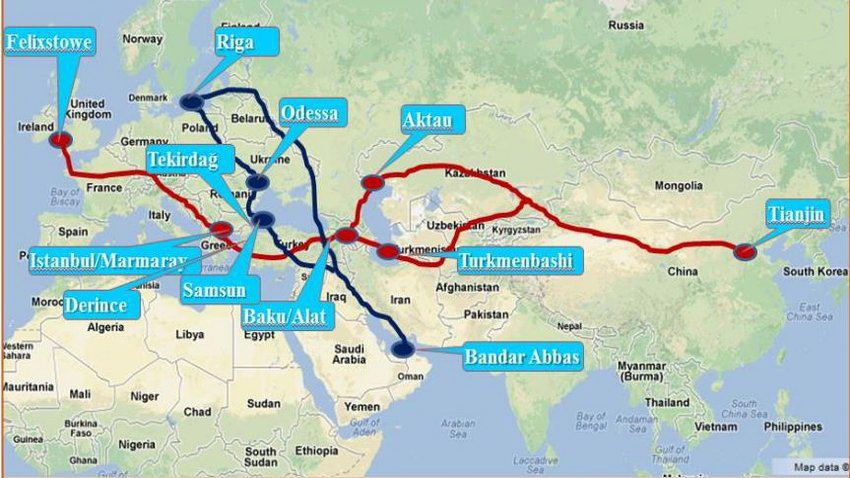BAKU, Azerbaijan, January 16. The Trans-Caspian International Transport Route (TITR, or Middle Corridor) can provide India with an additional opportunity to access the markets of Europe and Asia, Trend reports via a publication on the website of the reputable Observer Research Foundation (ORF), and relevant analysis.
The publication sees the above as a relevant option given the disruptions in the global supply chain and India's aspirations for constructive and strategic cooperation with the hydrocarbon-rich and strategically important regions of Central Asia and Eurasia.
The author of this research, a scholar affiliated with the foundation's program and a renowned expert on the Asian region, Ayjaz Wani, said that India, already a participant in the International North-South Transport Corridor (INSTC), can use the Middle Corridor to facilitate access to broader markets, including the European Union, the Caspian region, Central Asia, and beyond.
"After the completion of the Rasht-Astara railway line construction in 2027 (on the Iran-Azerbaijan border), the transit time on the western branch of the INSTC will be reduced to 10 days from the current 25–30 days. The traditional sea route of 16,129 kilometers takes 45 days, Wani noted. "Since the western branch of the INSTC intersects with the Middle Corridor in Azerbaijan, New Delhi can access European and Black Sea region markets through the Baku-Tbilisi-Batumi or Baku-Tbilisi-Kars routes in a shorter period."
He reminded that the Middle Corridor is a crucial route for Central Asian countries seeking to expand trade with Europe, aiming to reduce dependence on China and mitigate various geopolitical risks.
"Trade volume along the Middle Corridor is expected to triple by 2030 with the support of the US and other like-minded countries. This will lead to a 37 percent increase in trade between Azerbaijan, Georgia, and Kazakhstan and a 28 percent increase in trade between these countries and the EU. For India, the convergence of the Middle Corridor and INSTC will reduce supply chain risks and help New Delhi strengthen its influence in the region," said the expert.
He explained that the Middle Corridor has the potential to stimulate economic diversification, promote regional integration, and strengthen diplomatic relations.
"India can use its relations with the region to form new cultural and economic partnerships in Eurasia, even in the face of ongoing geopolitical issues worldwide," Wani noted.
He pointed out that tough Western sanctions against Russia due to the armed conflict with Ukraine prompted many countries worldwide to reconsider their supply chains and trade routes.
"The Middle Corridor has become one of the routes that has gained significant importance. This corridor, covering Central Asia, the Caspian Sea, and the South Caucasus and created to enhance connections between Asia and Europe, provides a much-needed alternative and faster deliveries compared to the Russian Northern Sea Route," noted the research author.
He mentioned that the route includes 4,250 kilometers of railway tracks and 500 kilometers of maritime routes, but it is 2,000 kilometers shorter than the Russian Northern Sea Route.
"The transit train through the Middle Corridor from China to Türkiye takes 12 days; to Prague (Czech Republic) it takes 18 days. From 2014 through 2021, 49,000 freight trains passed through the Middle Corridor, with an annual growth of 92.7 percent," the expert said.
He also said that the Middle Corridor accounted for only four percent of shipment volumes and five percent of the trade value between the EU and China.
Nevertheless, according to Wani, intra-regional trade dominated on this route between Central Asian and South Caucasus states and between Central Asia and Europe.
The expert provides data for October 2022, showing a 40 percent decrease in shipments between China and the EU via the Northern Sea Route.
"After the changes in the world in 2022, the Middle Corridor became a solution to comply with international sanctions (against Russia) and benefited from these changes. Thus, compared to 2021, container shipments along this corridor increased by 33 percent in 2022, and the region's countries intensified diplomatic interaction to improve infrastructure and address other issues," noted the ORF representative. "In particular, Azerbaijan, Georgia, and Kazakhstan announced the establishment of a joint railway enterprise in 2023, which will reduce delays on the route."
Besides, according to him, Europe is making every effort to expand the Middle Corridor for its own geostrategic and geo-economic interests, including diversifying sources to enhance energy security.
The route has also attracted significant attention from international financial institutions such as the European Bank for Reconstruction and Development (EBRD), the Asian Development Bank (ADB), the World Bank, and the US Agency for International Development (USAID).
"China, on its part, has attempted to integrate the Belt and Road Initiative with the Middle Corridor but has not fully invested in its development yet. In April 2023, the Chinese Ambassador to Georgia supported the Middle Corridor, and in July 2023, China and Georgia signed a strategic partnership agreement to expand cooperation in trade and strengthen the infrastructure of the Middle Corridor," Wani pointed out.
Overall, the research author sees significant prospects for the active involvement of the Middle Corridor in international trade and believes that a major economy like India should include this corridor in its sphere of interests.
Stay up-to-date with more news at Trend News Agency's WhatsApp channel







